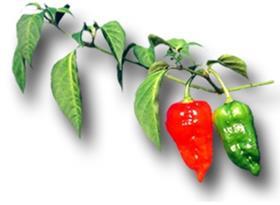
Something wicked this way comes… In the beautiful, rollingcountryside of the UK's south-west coastal region of Dorset, a chillipepper so devilishly hot that conservationists in India use it to scare off wild elephants is being grown to meet demand from increasingly daring consumers.
Farfrom its original home in the north-east of the Indian sub-continent,production of a new, hotter strain of the Naga Jolokia (cobra chilli),has been developed in West Bexington, Dorest, by pioneering grower Michael Michaud using seeds he bought from a local Asian grocer.
Nicknamedby locals as the Dorset Naga, the chilli has this week gone on sale inbranches of Tesco, which says it sees plenty of opportunity for sales growth in acountry known for its love of curry.
But, in a break withtradition for the fresh produce department, the retailer is warningconsumers to tread carefully before sampling the chilli, while chefsare being advised to wear gloves when preparing it.
Tesco exoticvegetable buyer Jonathan Corbett commented: “The Dorset Chilli issomething only absolute connoisseurs of very hot food and those withasbestos lined stomachs should even consider trying,' he says.“However, that said, there are an increasing number of 'chilli heads',as they are officially known, that not only savour but endorse thesetiny vegetables as being beneficial in helping sweat out the body’stoxins.'
According to Mr Corbett, the little devil has quite akick. “We trialled them in our test kitchens and even the hardestblokes in our team were brought to their knees. To give some indicationto the hot chilli pepper novice, this variety is so seeringly hot thatit makes a Vindaloo curry seem like a bowl of muesli,' he adds.
Thehotness of chilli peppers is traditionally graded on the Scovillescale, a measure of the degree of dilution required for the heat to beno longer detectable by taste.
By way of comparison, a sweet orbell pepper has a Scoville rating of zero, a Jalapeño has a rating ofbetween 2,500 and 8,000, and a Cayenne pepper has a rating of30,000-50,000. Habanero peppers can be rated as high as 350,000Scovilles.
The former record-holder, a Red Savina, gave areading of 577,000. But to everyone’s amazement the Dorset Naga hastrebled that, generating a fever-inducing 1.6m Scovilles.
Thetiny chilli recently made global news when it was used to make theworld’s hottest curry, known as a Bollywood Burner, in a Londonrestaurant.
It also created a stir last year when it went on aweek long trial at a Tesco store in the north-east city of Newcastle.Demand was reportedly so overwhelming that Tesco asked its supplier togrow more.
During the past year, demand for hot chilli peppersacross all UK retailers has grown by 18 per cent, swelling the marketto €11.4m (£9m) a year, according to independent retail analyst ACNielsen. At Tesco, the growth has been 29 per cent in the last year.
Tocope with the increasing demand, Tesco has doubled its chilli rangeinside the last 12 months to include more exotic varieties includingScotch Bonnet, Bird’s Eye, Cherry Bomb, Green, Red, Finger, Rocket andOrange Topaz.
As Mr Corbett explains, UK consumers havedeveloped more of a taste for hot, spicy foods. “Chilli pepper culturein the UK has really come on in the last few years and they are nolonger thought of as a culinary novelty,' he notes. 'In the past weused to primarily stock chilli peppers in areas where there was a largeAfro-Caribbean or Asian community, but nowadays we sell them in storesright across Britain.'
The Dorset Naga will be sold in 10g sachets containing up to three chillis, at a price of €1.13 (£0.89).






No comments yet